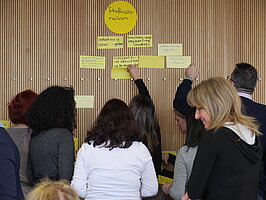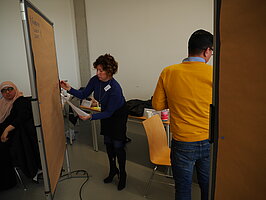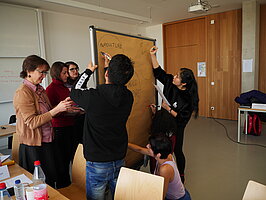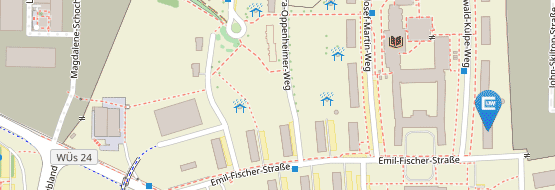Photolangage II



Aim of the method/strategy
- To promote reflection on students’ assumptions related to their own learning process
- To help future teachers to reflect on the way to provide teaching practices
- To promote peer discussion and sharing process among students
Setting
- Bachelors’ degree course ‘Teacher education and Training’
- Traditional classroom with rows of desks- University of Padova 50 students
Type of the course, curriculum, number of students
‘Metodologia del gioco’
Description of method/ strategy
The practice was realized in one lesson (2 hours) focused on the relationship between brain-based learning and education. In this perspective, the photolangage strategy was used to help students reflect on their learning assumptions and on the importance of providing teaching practices that take into account the brain learning process.
Step 1: The instructor prepared on a slide a set of 10 ‘knowledge cards’ (Fabbri & Munari, 2010) representing the most frequently used metaphors for describing and organizing our knowledge. Each card had a code number.
Step 2: The instructor prepared ten posters with a card code number on each of them.
Step 3: The instructor, after introducing the lesson, showed students the slide with the cards and asked: ‘Please, choose the card that best represents your learning process.’ (2 minutes)
Step 4: Students with the same card stood up next to the poster with the code number connected to the card they chose.
Step 5: Students were invited to discuss in groups ‘why they had chosen that card and why it could represent their learning process’. (15 minutes)
Step 6: Students were invited to make some notes/ drawings on the posters. (10 minutes)
Step 7: Each group was invited to choose a leader representative to share the key factors connected to the card chosen and their way to learn. (5 minutes per group; total: 20 minutes)
Step 8: Kahoot was used to summarize the key concept of the lesson. ( 5 minutes)
Step 9: Debriefing and final considerations (10 minutes)
Materials required
Instructor needed: projector, computer, posters, markers, sellotape Students needed their mobile phone to participate in Kahoot session
Origin and theoretical framework
Photolangage is a tool used to facilitate personal expression and verbal interaction in small groups. According to Bessell et al. (2007, p. 558), ‘it is a method that utilizes black-and-white photographs that have been carefully selected for their aesthetic qualities, their ability to promote thoughtful reflection within the viewer, and their strength in stimulating memory, emotions, and the imagination’. It was initially used in counselling and clinical therapy. It is used in many settings, including adult and community education (Griswold & Wigfall, 2015). This activity also facilitates critical thinking about learning developed by students concerning adult education and topics addressed in the course they attended. By learning, following Mezirow (2000), I mean knowledge and skills developed by students after facing a challenging situation that involves thinking and critical reflection and different ways of looking at the world, specifically at adult education and the topics addressed in the course.
Risks and advantages
Advantages:
- pictures represent effective metaphors that help students speak easily about their assumptions;
- they represent special mediators of students’ communications and personal feelings;
- they facilitate peer interaction and sharing;
- metaphors help students become aware of their assumptions and of their way to learn;
- they facilitate teachers’ and students’ reflection on their future teaching strategies.
Risks:
- time management with large class
Possible variations
The method can be used in different settings, such as faculty training, education, Continuing and adult education setting, professional development courses.
Other examples where you think it could be used
The method can be used in different settings, such as those in which learners discuss their own learning with other people, but also in groups involved in a problem solving process.
Recommendation
Ideally, a classroom with chairs and tables, but it can be used in any setting.
Anexes
Photolangage: how a picture can inspire a thousand words. American Journal of Evaluation, 28, 558-569.
http://photolanguage.co.uk/
https://www.youtube.com/watch?v=CBI84PpC_0A
Contact Person
Concetta Tino (concetta.tino@unipd.it)


